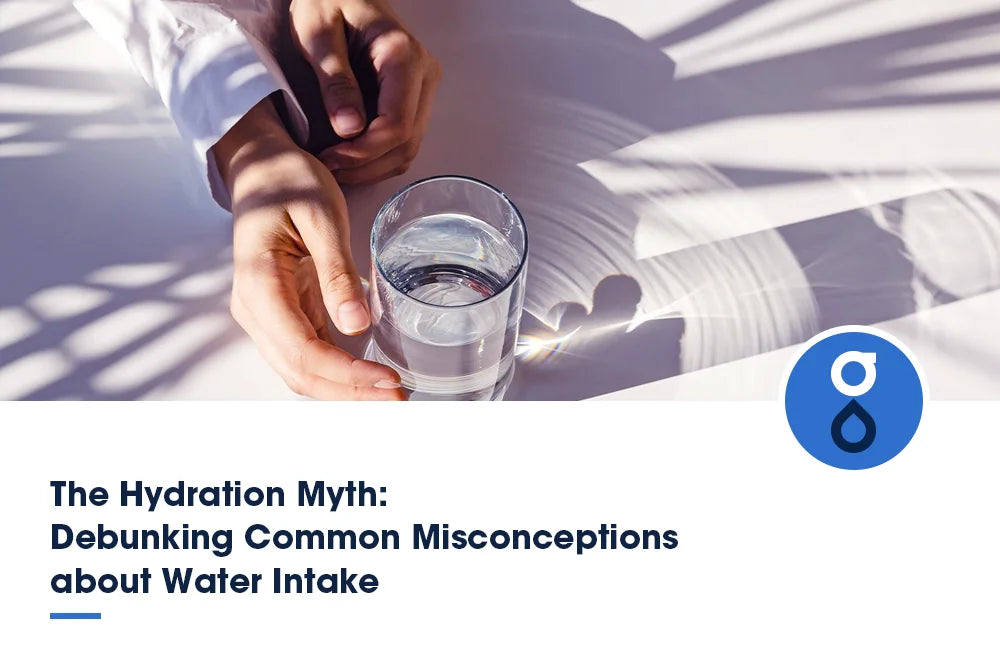Table of Contents:
Understanding the basics of desalination
The connection between desalination and the global water crisis
Desalinated water vs plain water: is it the same?
Traditional desalination methods
Innovations in desalination technology
How do desalination plants impact marine life and coastal ecosystems?
Conclusion
With the ever-increasing global population and the alarming rise in freshwater shortages, the future of desalination looks brighter than ever. Advances in technology and innovation are revolutionizing the field, making desalination more efficient, cost-effective, and environmentally friendly. In this article, we will explore the latest innovations in turning seawater into drinkable water and how they shape desalination's future.
Understanding the basics of desalination
What is desalination?
Desalination removes salt and other impurities from seawater to make it suitable for human consumption or agriculture. This technology has significant benefits, providing a vital source of fresh water in arid regions or during droughts. Recent advancements in desalination technology have made the process more efficient and cost-effective, increasing its potential for widespread adoption.
However, desalination plants can have environmental impacts, such as the disposal of concentrated brine back into the ocean, which can harm marine ecosystems. Despite these challenges, the prospects of desalination are promising, with ongoing research focusing on developing more sustainable and eco-friendly desalination methods. The global implications of desalination are substantial, offering a solution to water scarcity issues many countries worldwide face.
Why is desalination important?
Desalination is important for various reasons. Firstly, it plays a vital role in resource management by providing an additional source of fresh water, especially in regions facing water shortages. This technology contributes to sustainability by reducing the pressure on existing freshwater sources, thus helping to maintain ecological balance and support growing populations.
Moreover, desalination offers environmental benefits by lessening the strain on natural water bodies and ecosystems. Despite its importance, desalination does have environmental impacts, such as brine discharge and energy consumption. However, with ongoing technological advancements, these issues are being addressed to make desalination more sustainable and eco-friendly.
The challenges of desalination
Addressing the challenges of desalination requires a comprehensive understanding of its basic principles and processes. Desalination poses significant environmental impact concerns, primarily due to the energy consumption needed to convert seawater into fresh water. Removing salt from seawater demands substantial energy inputs, contributing to high operational costs and carbon emissions.
Achieving cost efficiency in desalination remains a critical hurdle for widespread adoption, as the initial setup costs and ongoing maintenance expenses can be prohibitive. Moreover, the disposal of brine, the concentrated salt solution left after desalination, presents a challenge as it can harm marine life and ecosystems if not appropriately managed.
Balancing the need for water security with the potential negative consequences of desalination processes is crucial for sustainable water management. As demand for freshwater rises globally, finding innovative solutions to mitigate the challenges surrounding desalination is essential for ensuring a reliable and secure water supply for the future.
The connection between desalination and the global water crisis

Desalination technology plays a pivotal role in mitigating the impacts of the global water crisis by providing a sustainable solution for freshwater scarcity. As the world faces increasing water scarcity due to climate change and population growth, desalination offers a viable way to access drinkable water sources. Here are some key connections between desalination and the global water crisis:
- Water scarcity: Desalination helps address water scarcity by providing an additional source of freshwater beyond traditional sources like rivers and groundwater.
- Environmental impact: While desalination can have ecological consequences such as energy consumption and brine discharge, technological advancements aim to minimize these impacts.
- Global implications: Desalination projects have global implications, especially in regions where water scarcity is a pressing issue. Implementing sustainable desalination solutions can have far-reaching benefits for communities worldwide.
Desalinated water vs plain water: is it the same?

When comparing desalinated water to plain water, there are key differences in their composition and potential implications for consumption. Desalinated water often undergoes a rigorous purification process, removing impurities like salt and minerals, which can benefit individuals needing low-sodium diets or regions facing water scarcity. However, this process can lead to a lack of essential minerals like calcium and magnesium, impacting taste and potential health benefits.
Desalination has environmental impacts, including energy consumption and brine discharge, which affect marine ecosystems and energy costs. Removing minerals during desalination can also have health considerations, potentially affecting those reliant on water for mineral intake. Public perception varies, with some viewing desalinated water as a sustainable solution while others raise concerns about its taste and environmental consequences.
Economically, desalination can be costly due to high energy requirements, infrastructure, and maintenance expenses. Despite its benefits, the differences between desalinated and plain water highlight the importance of considering various factors before widespread adoption.
Traditional desalination methods
Reverse osmosis: a widely used desalination method
Reverse osmosis stands out as a highly prevalent method for desalination due to its efficiency and effectiveness in removing salt from water. When considering reverse osmosis for desalination, here are some key points to keep in mind:
- Energy consumption: Reverse osmosis requires energy to push seawater through a membrane, but technological advancements have led to more energy-efficient systems.
- Sustainability concerns: While reverse osmosis helps provide fresh water, the energy requirements and brine disposal can have environmental impacts that need to be addressed.
- Cost efficiency: The initial setup costs for reverse osmosis desalination plants can be high, but the long-term operational costs are generally more manageable compared to other methods.
Regarding water quality, reverse osmosis is highly effective at removing salts, contaminants, and impurities, producing high-quality drinking water. However, the disposal of brine, the concentrated salt solution left behind after desalination, remains a challenge that requires sustainable solutions for long-term viability.
Thermal desalination: harnessing thermal energy to produce drinkable water
Thermal desalination methods utilize heat energy to convert seawater into drinkable water. Solar desalination harnesses the power of sunlight to evaporate seawater and then condense the vapor into freshwater.
Geothermal desalination utilizes heat beneath the Earth's surface to drive desalination, offering a sustainable and energy-efficient solution. These innovative desalination technologies are paving the way for more environmentally friendly and cost-effective methods of producing freshwater.
Energy-efficient desalination processes are crucial for reducing the environmental impact of water desalination. By optimizing energy consumption and utilizing renewable energy sources like solar and geothermal power, sustainable desalination becomes a viable option for regions facing water scarcity.
Innovations in desalination technology
Membrane distillation: a new approach to desalination
Membrane distillation presents a promising new approach to desalination technology, offering the potential for increased efficiency and cost-effectiveness. This innovative method uses a hydrophobic membrane that allows vapor to pass through while blocking liquid water.
Seawater is heated on one side by applying a temperature difference across the membrane, causing it to evaporate. The vapor then moves through the membrane to a cold side, condensing into fresh water, leaving the salt and impurities behind.
One of the key advantages of membrane distillation is its ability to operate at low temperatures, making it energy-efficient compared to traditional methods like reverse osmosis. Additionally, this process can handle water with high salinity levels, making it suitable for treating brackish and seawater.
Capacitive deionization: removing salt ions with electricity
Capacitive deionization efficiently removes salt ions from water in the desalination process by utilizing electricity. This innovative technique involves passing seawater through electrodes with an applied voltage, attracting and capturing salt ions on the surfaces of these electrodes. The captured ions are then flushed out, leaving desalinated water ready for consumption. Below is an example table illustrating the basic concept of capacitive deionization:

Carbon nanotubes: enhancing the efficiency of desalination
Carbon nanotubes possess high mechanical strength, large surface areas, and exceptional electrical conductivity, making them ideal for water filtration and desalination applications.
One key benefit of incorporating carbon nanotubes in desalination is their ability to effectively filter out salts and other impurities from seawater. Their unique structure allows for the rapid transport of water molecules while blocking salt ions, resulting in a more efficient desalination process. This enhanced efficiency leads to higher water production rates and lower energy consumption, addressing two major challenges in traditional desalination methods.
Carbon nanotubes can be functionalized to enhance their desalination capabilities further, such as by increasing selectivity towards specific ions or improving anti-fouling properties.
How do desalination plants impact marine life and coastal ecosystems?
Desalination plants can significantly impact marine life and coastal ecosystems, potentially disrupting the delicate balance of these environments. One primary concern is the intake and discharge of seawater during the desalination process. When large quantities of seawater are drawn into the plant for treatment, marine organisms such as fish larvae, plankton, and other small creatures can be trapped or killed.
Additionally, the high concentration of salts and chemicals in the brine discharge, a byproduct of desalination, can harm marine life and vegetation near the plant's outfall. Coastal ecosystems may also suffer from habitat destruction due to the construction and operation of desalination plants. The alteration of water flow patterns, changes in salinity levels, and the release of pollutants can all impact the biodiversity and health of these sensitive areas.
Conclusion
Innovations in desalination technology are revolutionizing how we turn seawater into drinkable water. Advances like membrane distillation and carbon nanotubes are making the process more efficient and sustainable. This is crucial in addressing the global water crisis and ensuring a reliable source of clean water for the future. By embracing these new technologies, we can create a more environmentally friendly solution to water scarcity.



















